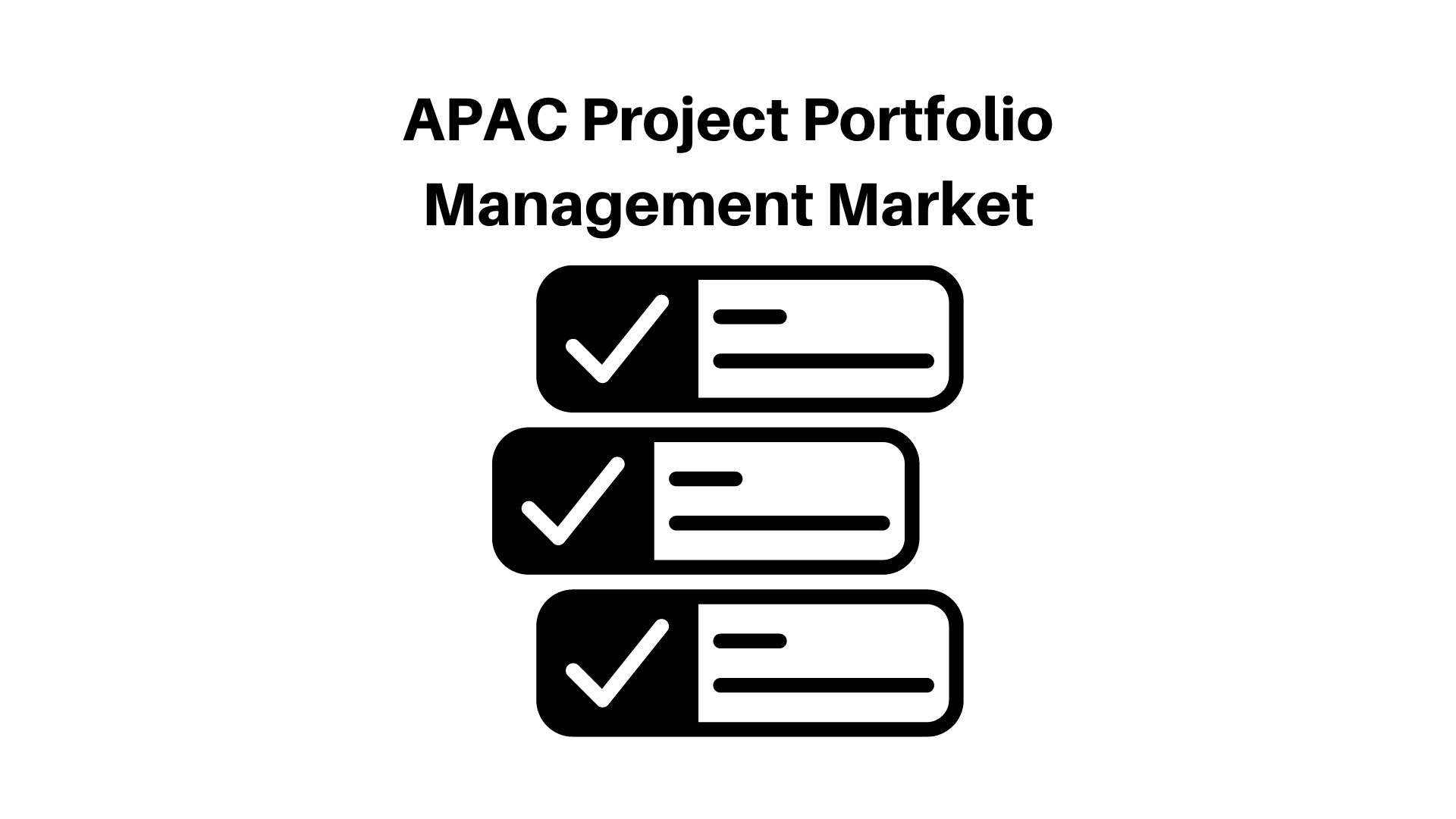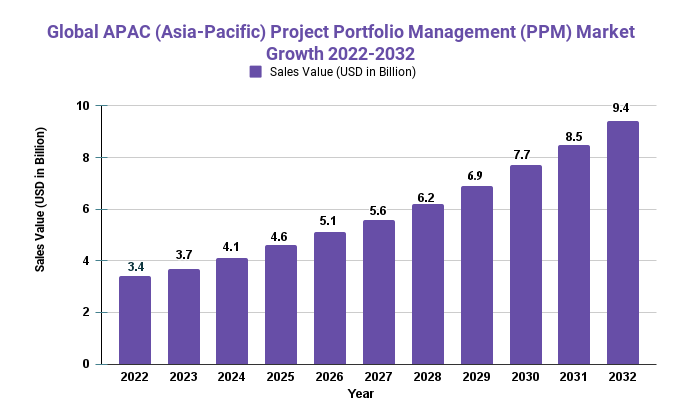APAC Project Portfolio Management Market Size will Observe Substantial Growth by 2032 with a CAGR of 10.8%

Page Contents
Market Overview
Published Via 11Press: In 2022, the Asia-Pacific Project Portfolio Management Market size was valued at USD 3.4 Billion and is projected to reach USD 9.4 Billion by 2032 at a compound annual growth rate (CAGR) of 10.8% from 2022-2032.
The Asia-Pacific Project Portfolio Management (PPM) market was anticipated to witness significant growth over the coming years. PPM is a process used by organizations to manage their project portfolios, which involves assessing, prioritizing, and selecting projects as well as monitoring and controlling project performance.
One of the major drivers of growth for the APAC PPM market is the rising adoption of cloud-based PPM solutions. Furthermore, small and medium-sized enterprises (SMEs) are increasingly turning towards these services to streamline their project management processes.
The growing need for efficient project management practices across industries such as healthcare, construction, and IT is expected to fuel demand for PPM solutions in the region. Furthermore, the growing adoption of agile methodologies in project management will further fuel growth within the APAC PPM market.

Drivers, trends, and challenges have an impact on market dynamics, which can impact businesses. Request for PDF sample report
Key Takeaways
- The APAC Project Portfolio Management Market is expected to experience strong growth over the coming years, due to factors such as increasing adoption of cloud-based PPM solutions and an increase in small and medium-sized enterprises (SMEs).
- Industries such as healthcare, construction, and IT are expected to fuel the demand for PPM solutions in the region.
- Additionally, the adoption of agile methodologies in project management is anticipated to further propel growth within the APAC PPM market.
- Key players in the APAC PPM market include Oracle Corporation, Microsoft Corporation, CA Technologies, Planview Inc., and SAP SE.
Regional Snapshot for Project Portfolio Management Market
- The APAC region encompasses countries such as China, Japan, India, Australia, and South Korea.
- China is expected to be the leading market for PPM solutions in APAC, due to the rising adoption of cloud-based systems and government initiatives promoting infrastructure development.
- India is expected to experience significant growth in the Project Portfolio Management (PPM) market due to an escalating number of startups and an increasing need for efficient project management practices across various industries.
- The adoption of PPM solutions in Southeast Asia is expected to be driven by the expansion of construction and manufacturing industries within the region.
- Australia and New Zealand are expected to experience significant growth in the PPM market, due to the increasing adoption of digital transformation solutions across various industries.
Drivers
- Cloud-based PPM solutions: Cloud-based PPM solutions offer several advantages, such as scalability, flexibility, and cost efficiency. As more organizations in the APAC region move their IT infrastructure to the cloud, so does the adoption of cloud-based PPM solutions.
- Rise of Small and Medium-sized Enterprises (SMEs): SMEs are an important contributor to the Asian region's economy. To optimize their project management processes, boost productivity levels, and reduce costs, these organizations are increasingly turning towards PPM solutions.
- Growing Need for Efficient Project Management Practices: The APAC region is experiencing rapid expansion in industries such as healthcare, construction, and IT. To guarantee the timely delivery of projects and reduce risks associated with project failure, effective project management practices are necessary. PPM solutions aid in evaluating, prioritizing, and selecting projects while monitoring project performance to help ensure success.
- Agile Methodologies Gain Popularity in Asia Pacific Region: Agile methods have seen a meteoric rise in popularity over the last several years, as PPM solutions that support them become increasingly sought-after for their ability to manage projects more flexibly and efficiently.
Restraints
- High implementation and maintenance costs: Adopting and running PPM solutions can be expensive, particularly for small and medium-sized enterprises (SMEs) with limited budgets. This could act as a deterrent to market growth.
- Lack of Skilled Workforce: Adopting and successfully using Project Portfolio Management (PPM) solutions necessitate a qualified workforce with expertise in project management and technology. Unfortunately, there is an acute shortage of such professionals across Asia-Pacific (APAC), potentially impeding market expansion.
- Data Security and Privacy Issues: PPM solutions require the storage and processing of sensitive project data, potentially raising concerns about data security and privacy in industries such as healthcare or finance.
- Resistance to Change: Some organizations may be reluctant to adopt PPM solutions due to a fear of the unknown, an inadequate understanding of their advantages, or a reluctance to invest in new technology.
- Integration Issues: PPM solutions must be integrated with existing IT systems and processes in organizations. Integration difficulties may arise due to differences in technology platforms, data formats, or business processes which could act as a deterrent to adopting PPM solutions.
Opportunities
- Growing Adoption of Artificial Intelligence (AI) and Machine Learning (ML) Technologies: AI and ML technologies can enhance the capabilities of PPM solutions, such as predictive analytics, resource allocation, and risk management. The integration of these two technologies could create new growth prospects for the PPM market in the APAC region.
- The emergence of Mobile-Based Project Management Solutions: Mobile-based PPM solutions offer project managers greater flexibility and mobility to manage projects from anywhere at any time. The rising popularity of smartphones and tablets in the Asia Pacific region may present new opportunities for these types of solutions.
- Growth of the Healthcare Sector: The healthcare sector in the APAC region is experiencing tremendous expansion due to factors such as an aging population, increasing healthcare expenditure, and digital technologies' adoption. PPM solutions can assist healthcare organizations in managing projects more effectively and improving patient outcomes – creating new opportunities for the PPM market in this region.
- Expansion of the Construction Industry: The APAC region's construction industry is forecast to experience tremendous expansion over the coming years due to government initiatives and infrastructure improvements. Project management software (PPM) can assist construction companies in managing projects more effectively and optimizing resources, opening up a world of possibilities for PPM vendors in this region.
Challenges
- Complex Regulatory Environment: The APAC region faces a challenging regulatory environment, with various regulations and standards across different countries. This may present an obstacle for PPM solution providers who must ensure they adhere to various regulations while offering their services within the region.
- Limited IT Infrastructure: Some countries in the APAC region lack adequate IT infrastructure, making it challenging for organizations to adopt PPM solutions. Additionally, issues such as slow internet speeds and connectivity problems could hamper the performance of these solutions.
- Cultural and language Barriers: The APAC region is culturally diverse, with different languages and business practices. This may present a challenge for PPM solution providers who must ensure their solutions are compatible with local languages and practices.
- Lack of Awareness and Education: Adopting PPM solutions requires awareness and education among organizations and project managers. Without adequate information about these solutions, a lack of interest may pose a barrier to growth in the APAC region.
- Competition from Local Players: In the APAC region, several local vendors provide PPM solutions at lower prices than international vendors. This could pose a challenge to international vendors who must compete with these players to gain market share.
Recent Developments
- On February 2021, Oracle Corporation announced the availability of their PPM Cloud solution in Asia Pacific (APAC). This solution offers advanced project management features and integrates with other Oracle Cloud applications.
- Wrike, a project management software provider, announced the opening of its operations in the Asia Pacific region on January 2021. With this move, Wrike hopes to grow its customer base and offer localized support and services in this region.
- In November 2020, Planview, a PPM software provider, announced the acquisition of Planisware, another provider of PPM solutions. With this acquisition, Planview plans to broaden both its product offering and customer base in Asia Pacific.
Key Market Segments
Type
- Software
- Service
Application
- Project management
- Portfolio management
- Demand management
- Financial management
- Resource management
- Others (Risk management and time management)
Key Market Players
- Upland Software#Inc. (US)
- Planview#Inc. (US)
- Planisware S.A.S. (US)
- Oracle Corporation (US)
- Software AG (Germany)
- SAP SE (Germany)
- Microsoft Corporation (US)
- Changepoint Corporation (US)
- CA Technologies (US)
- Hewlett Packard Enterprise Company (US)
- Clarizen (US)
- ServiceNow#Inc. (US)
Report Scope
| Report Attribute | Details |
| The market size value in 2022 | USD 3.4 Bn |
| Revenue forecast by 2032 | USD 9.4 Bn |
| Growth Rate | CAGR Of 10.80% |
| Regions Covered | North America, Europe, Asia Pacific, Latin America, and Middle East & Africa, and Rest of the World |
| Historical Years | 2017-2022 |
| Base Year | 2022 |
| Estimated Year | 2023 |
| Short-Term Projection Year | 2028 |
| Long-Term Projected Year | 2032 |
Frequently Asked Question
Q: What is Project Portfolio Management (PPM)?
A: Project Portfolio Management (PPM) is a set of practices and tools that help organizations to manage their projects, resources, and budgets in a coordinated and effective manner.
Q: What are the benefits of PPM solutions?
A: PPM solutions can help organizations to prioritize and select the right projects, allocate resources efficiently, monitor project progress, and manage risks and issues effectively.
Q: What are the key factors driving the growth of the APAC PPM market?
A: The key factors driving the growth of the APAC PPM market include the increasing adoption of digital technologies, the need for efficient project management practices, and the growth of various industries such as healthcare, construction, and IT.
Q: What are the key restraints for the APAC PPM market?
A: The key restraints for the APAC PPM market include the high implementation and maintenance costs, lack of a skilled workforce, data security and privacy concerns, resistance to change, and integration issues.
Q: What are the key opportunities for the APAC PPM market?
A: The key opportunities for the APAC PPM market include the increasing adoption of AI and ML, the emergence of mobile-based PPM solutions, the growth of the healthcare and construction industries, and the increasing focus on sustainability.
Q: What are the key challenges for the APAC PPM market?
A: The key challenges for the APAC PPM market include the complex regulatory environment, limited IT infrastructure, cultural and language barriers, lack of awareness and education, and competition from local players.
The team behind market.us, marketresearch.biz, market.biz and more. Our purpose is to keep our customers ahead of the game with regard to the markets. They may fluctuate up or down, but we will help you to stay ahead of the curve in these market fluctuations. Our consistent growth and ability to deliver in-depth analyses and market insight has engaged genuine market players. They have faith in us to offer the data and information they require to make balanced and decisive marketing decisions.